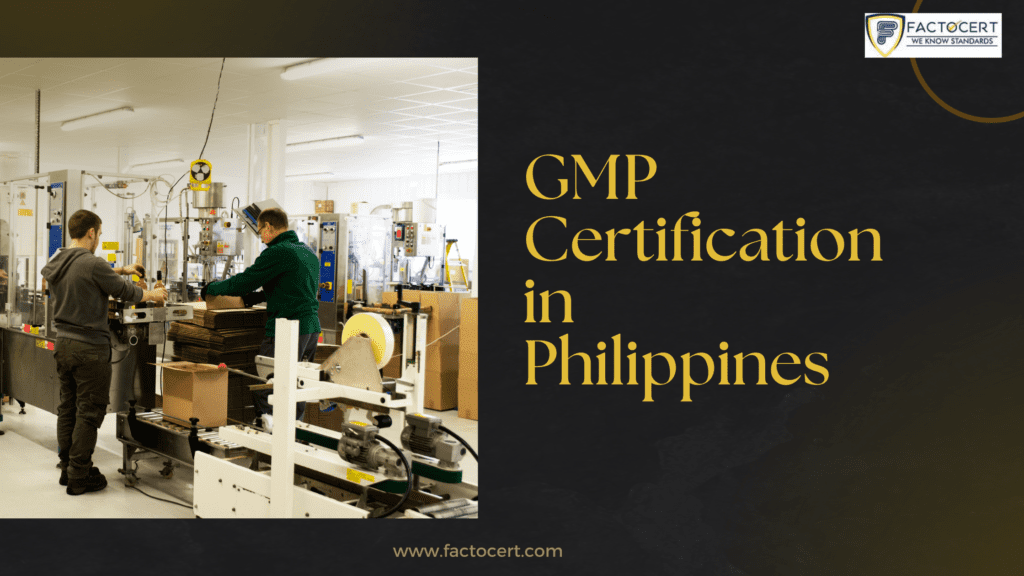GMP Certification in Philippines. The essential parts of Good Manufacturing Practice (GMP) are directly related to many parts of ISO 9001 Certification in Philippines (Quality Management Systems). This means that your business won’t have far to go to meet the standard’s requirements, saving you time and money while getting an internationally recognised ISO Certification.
Read on to find out why this could be a good business plan.
The five most important parts of GMP Certification in Philippines and how they fit into ISO 9001 requirements
The 5Ps, which stand for People, Products and Primary Materials, Processes, Procedures, Premises, and Equipment, are the most critical parts of Good Manufacturing Practices. These parts guide each manufacturing process step, ensuring that the final product’s quality and safety standards can be met.
As we’ve already said, many GMP requirements are identical to those in the ISO 9001 Standard. This link is shown very clearly in the table below:
1. People
Every manufacturing business needs people to do its work, and it’s up to the management to set clear roles and responsibilities that help the business reach its goals.
By making a training plan, it’s easier to find employees’ skills and manage their needs, taking into account talent gaps and people’s goals. A business could also set up a process for doing performance reviews regularly. This should lead to improvements in productivity and performance.
2. Primary Materials and Products
This is the most crucial part of both ISO 9001 and GMP Certificate. The quality of the product depends on the raw materials and how they are used during the production process. So, the business should build Quality Control into all stages of production.
ISO 9001 looks at every part of your business from a risk-based point of view. A risk assessment should be done at each step of the business process. Manufacturing risks should be found from getting the raw materials until the product gets to the first customer. Cross-contamination, tampering, and mislabeling are all risks that can hurt the business, the product, and the customer. It is essential to have plans in place to reduce these risks.
GMP Certification in Philippines can be used to control or reduce risks that have been identified. It will make sure that solid Quality Assurance processes are in place. This means that specifications will be sampled, checked or tested, and the results will be evaluated as part of the quality management system. Quality isn’t just about the result; it’s also about keeping an eye on and controlling everything along the way. So, GMP can help cut losses and waste while keeping the organisation and its workers safe.
To help meet Quality Objectives, one of the requirements of ISO 9001, it is crucial to have a robust Quality Management System.
3.Processes
GMP and the ISO 9001 Standard stress that processes must be written down and checked regularly. To ensure compliance, a business should have transparent processes written down and shared with employees.
Having set processes makes it easier to find and control risks, keep an eye on them, and look into deviations. It also makes it easier for people to share their knowledge and ensures the business can keep quality high at every process step.
4.Methods
In addition to what we discussed before, Clause 7.5 of ISO 9001 and GMP says that a business must write down how it does things. These can be rules, methods, flowcharts, or lists of steps to finish essential tasks or processes.
Having written procedures ensures consistent results because any significant changes during production can be easily tracked down, looked into, and fixed. These are often called Work Instructions or Standard Operating Procedures (SOPs).
Operators must be taught how to do these tasks correctly and quickly, including completing the proper paperwork so they can be tracked.
5.Premises and Equipment
Clause 7.1.4 of ISO 9001 says that the environment must be suitable for work. This requirement is related to GMP Certification in Philippines, which spells out the requirements for facility management.
Companies that make things should try to build their facilities and equipment so that they can be cleaned well and cross-contamination doesn’t happen. For example, places that make food should have cleaning and sanitation schedules and programmes to ensure that microbes are gone.
Electrical power, lighting, temperature, humidity, and airflow all need to be correct, and they can’t hurt the products or people in any way, either directly or indirectly. At the same time, they are being made, stored, or used.
Pest control is significant in manufacturing facilities, so a control schedule should be made to keep mice and other unwanted animals out, along with a drainage system and a plan to make sure all entry points are closed or sealed. Maintenance and equipment calibration must be done regularly by trained and skilled people, and they should keep track of everything.
The ISO 9001 Certification in Philippines also says that the business must have a programme for maintenance and calibration. This is important for checking and validating results, especially when it comes to lab tests.





